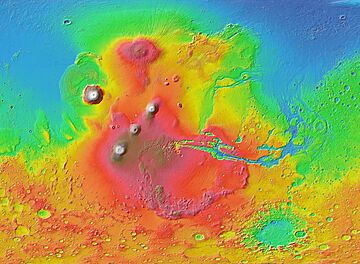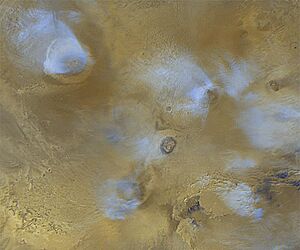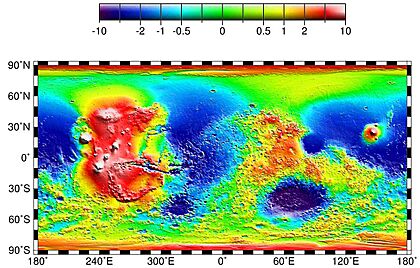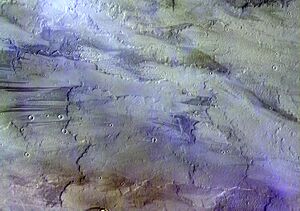Tharsis facts for kids

The Tharsis region (in red and brown) is a huge bulge on Mars. This map was made using data from the Mars Orbiter Laser Altimeter (MOLA).
|
|
| Feature type | Volcanic plateau, volcanic province |
|---|---|
| Location | Eastern hemisphere of Mars |
| Coordinates | 0°00′N 260°00′E / 0.000°N 260.000°E |
| Diameter | ~5 000 km |
| Peak | ~7 km (excluding volcanoes) |
| Eponym | Tarshish |
Tharsis is a giant volcanic plateau on the planet Mars. It's a massive bulge on the planet's western side, near the equator. This region is famous for having the largest volcanoes in the entire Solar System.
These volcanoes include three huge shield volcanoes known as the Tharsis Montes: Arsia Mons, Pavonis Mons, and Ascraeus Mons. The tallest volcano on Mars, Olympus Mons, is also located near the edge of the Tharsis region. The name "Tharsis" comes from the ancient name for a land at the far western edge of the known world.
Contents
Where is Tharsis and How Big Is It?
Tharsis is so big that it's often called the Tharsis bulge. It is the largest single feature on the surface of Mars. It's like a continent-sized bump on the planet.
Because it doesn't have clear borders, its exact size is hard to measure. Generally, the bulge is about 5,000 kilometers (3,100 miles) across. It rises up to 7 kilometers (4.3 miles) high, and that's not even counting the giant volcanoes that sit on top of it. The Tharsis region covers up to 25% of the entire surface of Mars.
The Tharsis region has several different parts. In the north is a huge, low-lying volcano called Alba Mons. In the central part are the three massive Tharsis Montes volcanoes. The southern part of Tharsis is a high plateau that includes areas like Syria Planum.
How Did Tharsis Form?

Scientists believe Tharsis sits over a hot spot, which is a place where a giant column of hot rock rises from deep inside the planet. This is similar to how the islands of Hawaii formed on Earth.
This hot spot pushed up the crust and poured enormous amounts of lava onto the surface. Mars does not have plate tectonics like Earth, where the crust is broken into moving plates. On Mars, the crust stayed in one place over the hot spot. This allowed lava to build up for billions of years, creating the huge Tharsis bulge and its gigantic volcanoes.
The weight of Tharsis is so great that it has cracked the Martian crust around it. This created a network of giant fractures that spread out from the center of the bulge, stretching across a large part of the planet.
Did Tharsis Create the Martian Atmosphere?
The volcanoes of Tharsis didn't just release lava. They also released huge amounts of gases, like carbon dioxide and water vapor. Some scientists think that the gas from Tharsis magmas could have been enough to create a thick atmosphere on early Mars. It might have even released enough water to cover the whole planet in a shallow ocean.
These gases also included elements like sulfur, which would have mixed with water to form acid. This acid rain could have helped shape the surface of Mars long ago.
Frost on the Giant Volcanoes
In a surprising discovery, probes from the European Space Agency (ESA) found water frost on the peaks of the Tharsis volcanoes. Scientists used to think it was impossible for frost to form at the equator of Mars. This discovery helps us understand how water moves around the planet today.
Did Tharsis Move the Planet's Surface?
The Tharsis bulge is incredibly massive. It weighs about the same as the dwarf planet Ceres. It is so heavy that it likely changed how Mars spins on its axis.
Some studies suggest that Tharsis first formed closer to the north pole of Mars. Over millions of years, its immense weight caused the entire outer layer of the planet to shift. This process, called true polar wander, would have dragged the Tharsis region down toward the equator.
If this happened, it would have caused dramatic climate changes all over Mars. Areas that were once at the poles could have moved to the tropics, and vice versa.
See also
- Geography of Mars
- Geology of Mars
- Volcanism on Mars



